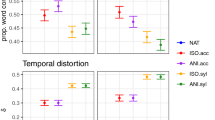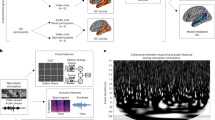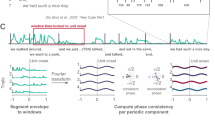Abstract
THE chief characteristic of rhythm perception is the subjective grouping of objectively separate events. In a rhythmic sequence of identical tone-bursts, adults do not perceive the repetition of a single sound, but a recurring configuration which has temporal form. Such a sequence is organised according to the Gestalt law of proximity1,2. Organisation of temporal form has never been studied systematically in pre-verbal infants. We present here results suggesting a precocious achievement of this function and contrasting with previous research3 which failed to demonstrate organisation of spatial form by babies in accordance with the proximity law.
This is a preview of subscription content, access via your institution
Access options
Subscription info for Japanese customers
We have a dedicated website for our Japanese customers. Please go to natureasia.com to subscribe to this journal.
Buy this article
- Purchase on SpringerLink
- Instant access to full article PDF
Prices may be subject to local taxes which are calculated during checkout
Similar content being viewed by others
References
Koffka, K. Principles of Gestalt Psychology (Harcourt, Brace and World, New York, 1963).
Fraisse, P. Les Structures Rythmiques (Publications Universitaires de Louvain, Louvain, 1956); Psychologie du Rythme (Presses Universitaires de France, Paris, 1974).
Bower, T. G. R. Psychon. Sci. 3, 323–324 (1965); Percept. Psychophys. 2, 74–76 (1967).
Maurer, D. in Infant Perception: From Sensation to Cognition 1 (eds Cohen, L. B. & Salapatek, P.) 1–76 (Academic, New York, 1975).
McKenzie, B. & Day, R. H. J. exp. Child Psychol. 11, 366–375 (1971).
Author information
Authors and Affiliations
Rights and permissions
About this article
Cite this article
DEMANY, L., MCKENZIE, B. & VURPILLOT, E. Rhythm perception in early infancy. Nature 266, 718–719 (1977). https://doi.org/10.1038/266718a0
Received:
Accepted:
Issue Date:
DOI: https://doi.org/10.1038/266718a0



